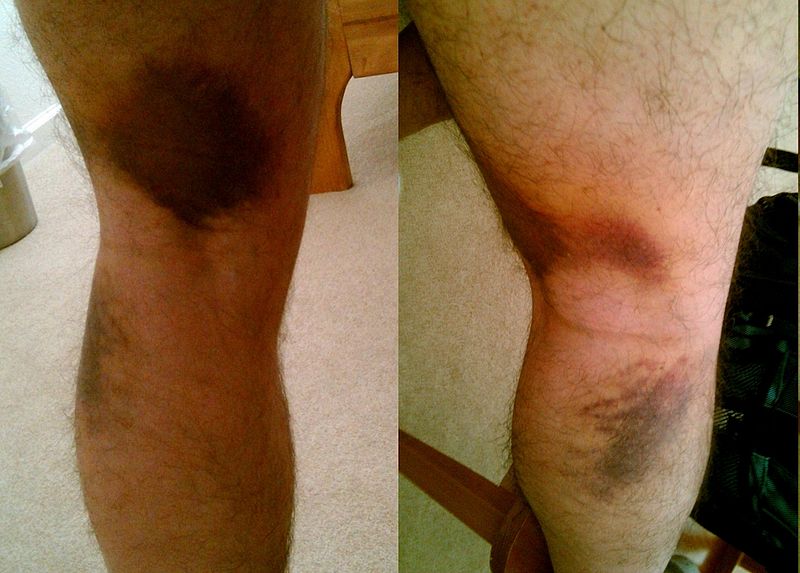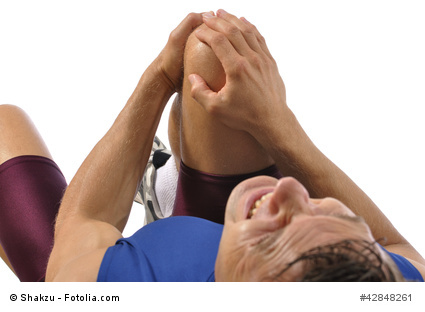Hamstring Injuries Are Very Common
In fact, hamstring injuries are among the most common sports injuries of all. They are particularly common in those who play kicking sports or those who play sports that involve rapidly accelerating and stopping. Just to quickly recap with you in case you are unfamiliar with the hamstrings, they are three muscles in the back of your upper leg that travel below your knee. They are mainly involved in extending your upper leg backwards and flexing your knee.
When people sustain a hamstring injury, they often say that they “pulled” a hamstring. What this means is that they strained the muscle, or tore its muscle fibers due to them overstretching. When this happens, swelling and bruising may occur underneath the skin due to bleeding and it can look quite painful! Depending on how severe the strain was will determine how bad the bruise will look. The guy below, for example, looks like he had a pretty nasty hamstring strain!

Page URL: http://commons.wikimedia.org/wiki/File%3A2010-10-02_pulled_hamstring.jpg
Image Attribution:
By Daniel.Cardenas (Own work) [CC-BY-3.0 (http://creativecommons.org/licenses/by/3.0)], via Wikimedia Commons
Ways In Which Hamstring Injuries Happen
There are many things that cause you to injure your hamstrings. In my video I talked about four ways hamstring injuries occur, but here I’m going to give five.
A Lack of Flexibility causes Hamstring Injuries
It’s true! When your hamstrings are tight, they will experience greater tension when you move when you do activities like running or kicking a ball. If your hamstrings were limber, less tension would be placed on them when performing those movements. Remember, the hamstrings don’t just flex the knee, they also contract to slow the knee down as it extends straight. If you have flexibility, doing an action like kicking a ball shouldn’t be a problem. But if your hamstrings are very tight, the sudden kicking motion that straightens your knee could overstretch them and potentially cause a muscle strain. That will lead to your hamstrings perhaps developing a big nasty bruise like what you saw above and greatly limit your activity levels! So remember to stretch!

Weakness causes Hamstring Injuries
That’s right, if your hamstrings are weak, they are more likely to become injured! Up above I stated that the hamstring muscles not only flex your knee, but they also contract to control the speed of your knee as it extends, like when you run or kick a ball. Hamstring injuries happen when those muscles are weak, so when your quadriceps extend your knee, your hamstrings are not as able to resist the forward motion of the lower leg. This can lead to the hamstrings overstretching and you getting a muscle strain. So remember, when in the gym, don’t only focus on working out your quadriceps! What you are aiming for is muscle balance in your body, so workout your hamstrings along with your quads!
Tiredness causes Hamstring Injuries
That’s right, being tired and fatigued can also cause you to injure your hamstring muscles. When your hamstring muscles are fatigued, they are not going to perform their job as effectively. So if you have been running for a long time and your hamstring muscles become tired, you could go into bad movement patterns with your leg that you would have ordinarily avoided when not fatigued. These bad movement patterns happening again and again and the hamstrings not being able to perform their job as well can certainly lead to you injuring yourself.
A Previous Injury can cause Hamstring Injuries

Perhaps the number one factor that can lead to you injuring your hamstrings is having previously injured them. When you injure a muscle, your body is going to compensate and move differently to protect itself from further damage. However, when your muscle finally heals, your body may not transition to the way it used to move. Instead, your body may stick to its new way of moving. The problem is that this new way of moving is not as efficient. Therefore, you may end up re-injuring yourself just because this new movement pattern is not a good one. Also, after you strain your hamstring muscles, scar tissue may be laid down. The problem with this is that scar tissue is not as flexible as the original muscle tissue that was there. This stiffness can cause you to injure your hamstrings again.
Although the glutes and hamstrings are two different muscles, one being weak can still cause injury to the other. When the Gluteus Maximus muscle is weak, the hamstrings will have to overwork to compensate for that weakness. This is because the Gluteus Maximus muscle and the Hamstrings both do hip extension. So when your glutes are weak, the hamstrings have to go on overdrive to compensate. Them repeatedly overworking will overtime lead to an injury.

So remember, don’t sit on your butt all day and develop weakness there! I wrote an article on developing stronger butt muscles too if you are interested in reading.
Conclusion on Hamstring Injuries
Looking at all the above ways in which hamstring injuries happen, it is easy to see why it is such a common injury! From people not working out their butt enough, to having tired hamstrings, to them being weak, stiff, or previously injured, there are a multitude of ways an injury can occur. So remember to stretch those muscles! Workout that butt! Workout your hamstrings so a muscle imbalance does not occur between them and the quadriceps. These things are not that hard to do and doing them could perhaps save you a lot of grief and agony in the future!
